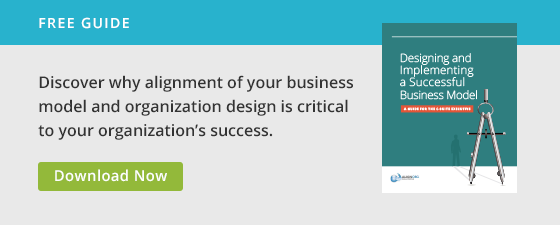Business model transformation can deliver a tremendous amount of value for an organization, competitively speaking. Recently, a potential client who was trying to change how her sales force is set up asked me, “what are some of the best business models you’ve seen?”
That’s a tricky question. There are many effective business models out there. A few that come to mind are ride sharing programs like Uber and Lyft; apartment and home sharing like Airbnb; and companies like Amazon and Apple that are doing remarkable things by integrating media, hardware, services, and partners. It’s easy to focus on the outward manifestation of these companies’ business models, but in my mind the most important thing to realize is that regardless of what it ends up looking like, what they’re really doing for the user is creating an ecosystem or environment that delivers a great deal of value.
Modeling for Value
A company like Apple has designed a really effective business model that not only delivers a lot of value to the consumer, but brings a lot of financial value to the company as well. People love their devices, but part of that “love” is having an app store with offerings from thousands of different developers where they can find an app that will fulfill virtually any need they have—and every time they do, Apple makes money.
Uber is another good example. It has become the most highly valued tech company (in spite of recent struggles), with a valuation of close to $70 billion—without really owning anything. Uber doesn’t maintain a fleet of vehicles. They don’t employ drivers (in most jurisdictions). They don’t have buildings other than a few office buildings. They simply bring drivers and riders together virtually and in the process create a huge amount of value.
That, in my mind, is what lies at the heart of a successful business model, and it’s why we at AlignOrg Solutions don’t just pick a business model and let it become our favorite. Instead, we design a model that fits what you’re trying to accomplish while delivering a high degree of value to both the organization and its customers.
Determining the Right Business Model for Your Organization
The core question in business model transformation is, “What is the right business model for this organization?” The right business model is one that:
- Enhances your intended differentiation. This is essential to stay competitive in the marketplace.
- Delivers value. This includes both value to the customer or user, and value to the company or the facilitator of the platform or model.
- Is sustainable and self-reinforcing. A sustainable business model is not dependent on a single service or product. It’s not a one trick pony. Like a flywheel, it constantly creates value for the organization and its customers. Over time, it may need to be refreshed or renewed or changed out altogether, but in general it delivers value on an ongoing and consistent basis.
To find the right business model, you have to weigh the relative pros and cons of doing one thing versus another out of the infinite options available to you.
For example, when someone uses a ride sharing program, the person really paying for it is the driver. Yes, the consumer pays to get the ride, but the money being paid to Uber or Lyft is coming from the driver. That’s a choice. There are pros and cons to it, because drivers might like it a lot more if the service was free to them. However, customers would probably think twice if they knew that every time they use Uber they have to pay a $5 booking fee.
Every business model transformation requires making many of these types of decisions. And so when I was talking to this leader about options for setting up her sales organization, we were talking about pros and cons. We were saying, “one advantage to approaching it a certain way is this, but it’s going to come with some risks and tradeoffs.” That’s a powerful conversation because it allows you to evaluate in advance the potential for what‘s going to work and what’s not.
Leveraging Data to Advantage
This particular leader impressed me for a number of reasons, not the least of which is that she is using data to help with the decision making. This might seem like an obvious course of action, but in reality a great number of leaders go with the gut feeling—“I think the customer will appreciate it if we do it like this”— instead of finding out for sure if that’s an approach the customer will really appreciate.
It’s not that people don’t want the data, it’s that they’ve gotten used to what’s worked in the past and are stuck in the comfort zone of using that as the exclusive determinant of success in the future. However, staying in comfort zones rarely leads to improvement. As I was talking with this leader she said, “we’ve been really successful for a long time, and we have a lot of ‘tribal lore’ around here about what works and what doesn’t work, but what we don’t have is data to validate why people are really buying, what’s motivating them, or what’s keeping them with us.” Her point was that in order to really figure this out we’ve got to get better data so we can make informed decisions.
So this leader, is going into all of her respective markets and analyzing them to find out how customers are making decisions, how they are buying, what they are buying, what’s motivating them to buy, their retention rate—all those things that someone in a marketing and sales world needs to consider. That way, when we’re making decisions as to how we set the organization up, we’ll be basing them on solid data rather than guesswork.
A Model of Sustainable Value Creation
Ultimately, successful business model transformation hinges on value. Weighing the pros and cons and using data to find a business model that enhances your differentiation and delivers as much value as possible to customers in a sustainable way will deliver a business model capable of delivering value to customers and the organization alike.

